Family : Brassicaceae

Text © Prof. Pietro Pavone

English translation by Mario Beltramini
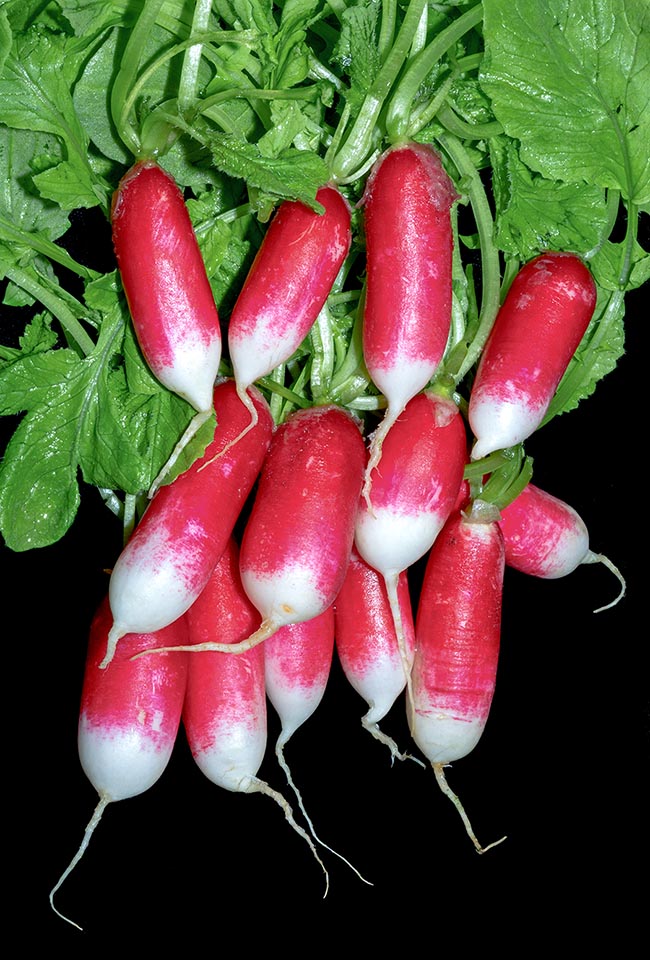
Raphanus sativus is an important species cultivated in most temperate regions of the World. The axis of the plant has a tuberized root where the reserve substances do accumulate. Here, the cultivar ‘French Breakfast’ © G. Mazza
Raphanus sativus L., commonly called radish, is an important species cultivated in most of the temperate regions of the world.
Following the classification APG, it belongs to the Brassicales order, Brassicaceae family, Brassiceae tribe.
However, its correct systematic classification is controversial. After some authors it is to be considered as a subspecies of Raphanus raphanistrum L and, therefore, its nomenclature ought to be Raphanus raphanistrum subsp. sativus (L.) Schmalh.
After other authors Raphanus sativus L., cited by Linnaeus in his opus Species Plantarum (1753), is a valid and accepted species.
This is confirmed by the study sponsored by the German foundation DFG (German Research Foundation), following the priority programme SPP 1529 “Adaptomics − Evolutionary plant solutions to ecological challenges / Molecular mechanisms underlying adaptive traits in the Brassicaceae s.l. (2011-2018)” that has produced the online database BrassiBase which we have adhered to.
Raphanus comes from the Greek “ῥάφᾰνος” (ráphanos), horseradish, radish, from “ῥα” (rha), contraction of “ῥίζα” (rhiza), root, and from the verb “φαίνω” (phaíno), to appear, that is, having a well visible root.
According to another interpretation, “phaíno” might allude to the fast growth of the plant.
The specific epithet sativus comes from the Latin “satum”, past participle of “sero”, to sow, hence sown, planted, that is plant destined to the cultivation
The origin of Raphanus sativus is uncertain.
It is supposed that this species may have originated in Europe and in Asia, and, perhaps, also in the Mediterranean area.
It is plausible that it has formed from the domestication of wild species closely related to it such as Raphanus raphanistrum L present in the Mediterranean, in western Asia and in Europe, Raphanus raphanistrum subsp. landra (Moretti ex DC.) Bonnier & Layens diffused along the European Atlantic Ocean coasts, in the Mediterranean and in the Black Sea or Raphanus raphanistrum subsp. rostratus (DC.) Thell. distributed from Greece eastwards up to the Caspian Sea.
Some molecular data indicate that the evolutionary origin of Raphanus sativus may come from the simultaneous divergence of the genus Raphanus and Brassica nigra from a common hexaploid ancestor and the divergence was caused by an event of triplication of the entire genome.
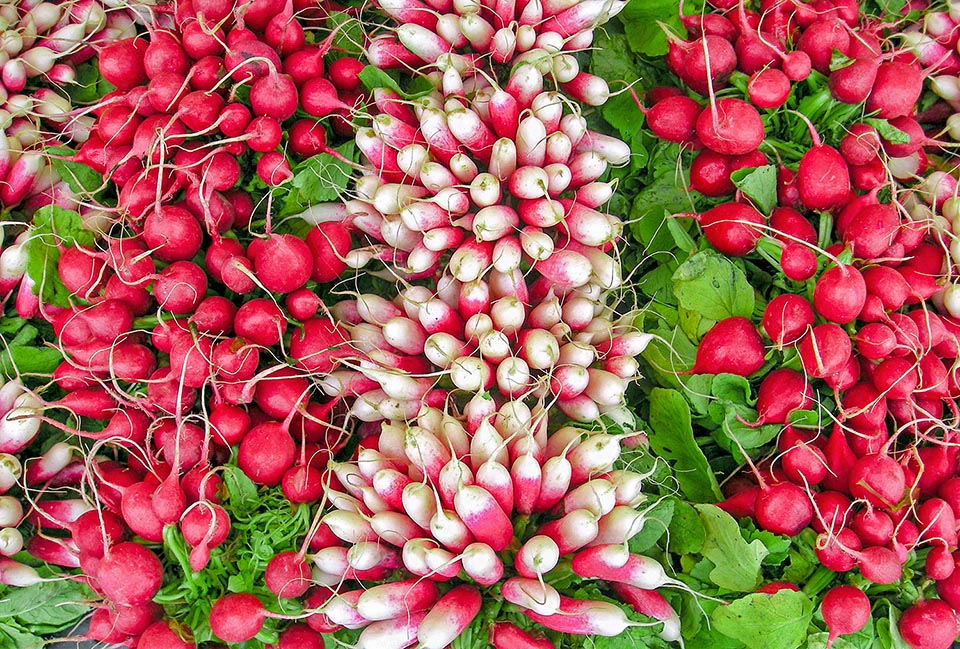
Cultivars exposed for sale in a local market. ‘French Breakfast’, in the centre here, is immediately recognized for the long red root with the white tip. On the sides ‘Cherry Belle’, summer variety with small round roots, smooth and scarlet with hot white pulp. It is frequent in the North American supermarkets and in France © Jan-Tore Egge
Furthermore, other molecular studies indicate Europe as the centre of origin of domestication and southern and eastern Asia, where many other forms are present, as other independent centres.
This hypothesis is also corroborated by the presence in Asia of wild populations of radishes. Moreover, with the increase of the sequenced samples of the various cultivars of Raphanus sativus it is possible to better reconstruct its origin and its migrations.
As a matter of fact, a recent molecular study (2020) molecular study made on 510 cultivars of Raphanus sativus has evidenced four groups of radishes genetically homogeneous. It is thought that the group native to western Europe (Mediterranean – Black Sea) would have migrated to the Asian south-east and, later one, moving more eastwards, would have given rise to another group that in turn would have given origin to two more groups, one in China and Korea and the other in Japan. This leads to deduce that the present forms of cultivated radishes have formed independently in each one of these four areas with few introgressions.
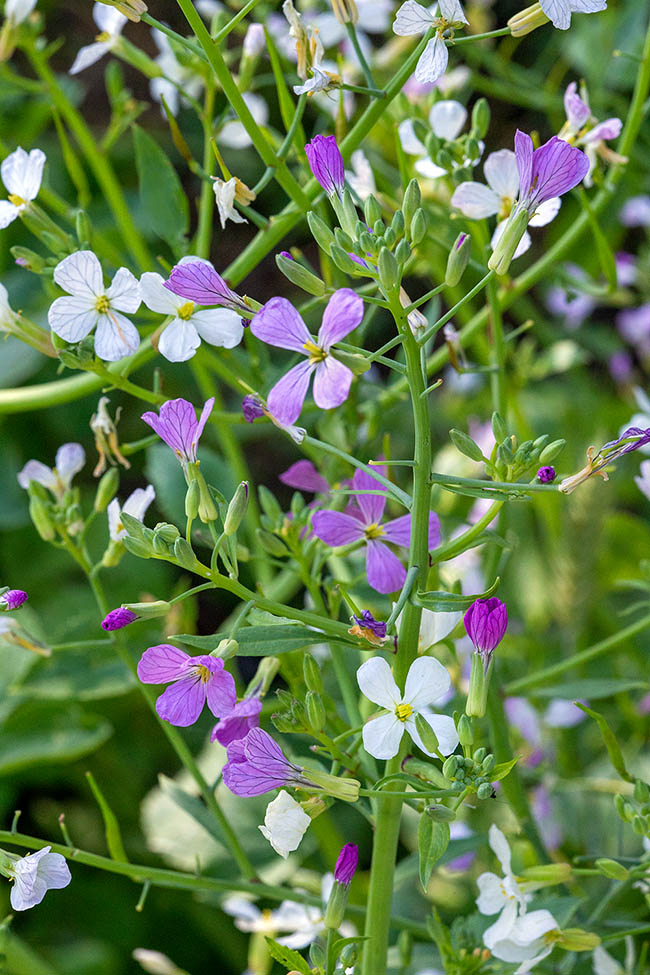
The flowers, merged in racemose erect terminal inflorescences, are scented, from white to lilac © Giuseppe Mazza
It is believed that the origin of its domestication can be traced back more than 5.000 years ago. According to Herodotus (484 BC – 425 BC ca.), to the workers who were building the pyramid of Cheops, Egyptian pharaoh of the IV dynasty (2589-2566 BC ca.), was given a daily ration of radishes because they were thought to have a lot of energy due to their spicy and warm taste. Usually, the radishes were consumed in the evening, together with other vegetables with meat and fruits.
This is the proof that already in that time, in the old Egypt, these plants were known.
However, probably, were consumed only the leaves while the roots were mainly utilized in medicine for treating breathing problems and for treating locally the insects’ stings.
Greeks cite them in their III century BC texts, whilst the Roman authors (100 AD) have described several varieties of it: round, long, sweet, pungent, etc.
In England the radishes aver common already in 1586. In America, after Columbus’ arrival, the first introduced cultivations were rightly those of the radishes, so much that after a few years from the Europeans’ arrival, they were already present in Mexico, in 1500 ca., and in Haiti in 1565.
In the Middle Age, in Europe, was consumed a variety of radishes calles Black radishes (Raphanus sativus L. var. niger, nowadays considered a cultivar (‘Black Spanish’) of Raphanus sativus var. sativus. The black radish was utilized due to its tolerance to cold and to its capacities of being a source of food during the winter period. In the XIX and XX centuries, with the introduction of new cultivars, this slow growing fibrous variety, has been replaced by smoother radishes, coloured and easy to commercialize.
Raphanus sativus is an annual or biennial plant with the hypocotyl axis usually enlarged that continues also in the root, that appears tuberized (napiform), that is very thickened, where accumulate reserve substances.
Secondary roots with many absorbent hairs are formed from it.
Therefore, the root is taproot and its enlargement begins in the hypocotyl axis. We have long roots, semi-long, globose-long, round, etc.. The inner colour can be white, pink, red, whilst the outer one is white, yellow, pink, red, violet, black and at times bicoloured.
The stem is 20-100 cm tall, poorly ramified, glabrous or bristly at the base. The basal leaves are up to 30 cm long, petiolate, lyrate-pinnatisect, with 2-3 pairs of lateral segments and a terminal one, bigger. The upper leaves are oval, oblong-lanceolate.
The flowers are merged in terminal racemose inflorescences, erect, long, with 10-50 flowers with a diameter of 1,5 cm, fragrant, white to lilac, supported by an up to 2,5 cm long peduncle. The sepals are 4, oblong-linear, 6-10 mm long; the petals, also 4, are spatulated, clawed, 15-20 mm long. The stamens are 6, tetradynamous, and the ovary is superior with 3-4 mm style.
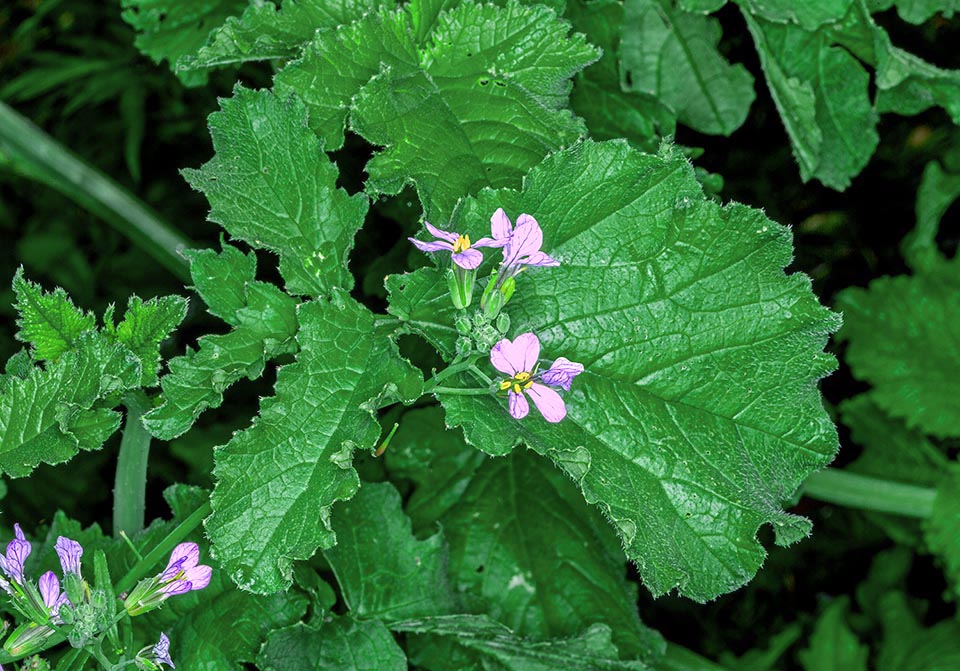
The 20-100 cm tall stem is poorly ramified, glabrous or bristly at the base. the basal leaves are up to 30 cm long, petiolate, lyrate-pinnatisect, the upper ones are oval, oblong-lanceolate with 2-3 pairs of lateral segments and a terminal one bigger. Chopped in water, they fight flu and the young ones are cooked like spinach © G. Mazza
The fruit is a 30-50 (60) × 8-12 mm cylindrical silique, usually formed by two overlapped valves, the lower one, rudimental, usually without seeds and the upper one more or less cylindrical, indehiscent, long, torose or moniliform, spongy and divided in 2-12 monospermic compartments, with 10-15 mm long conical beak. The seeds, of brown yellowish colour, are in number of 2-10, 3-4 mm long, ovoid or sub-spherical in shape, with conduplicate cotyledons.
The somatic chromosome number is à 2n = 18. Thanks to the studies of the sequences of the mitochondrial DNA and of the DNA of the chloroplasts the genome of Raphanus sativus is known at the 76% with about 61.500 genes, number sufficient for beginning the construction of the genetic reference map.
Raphanus sativus grows at altitudes between the 200 and 1200 m. At times, it escapes cultivation and can be found along the banks of watercourses, in the road edges, in the ditches, in the abandoned lands.
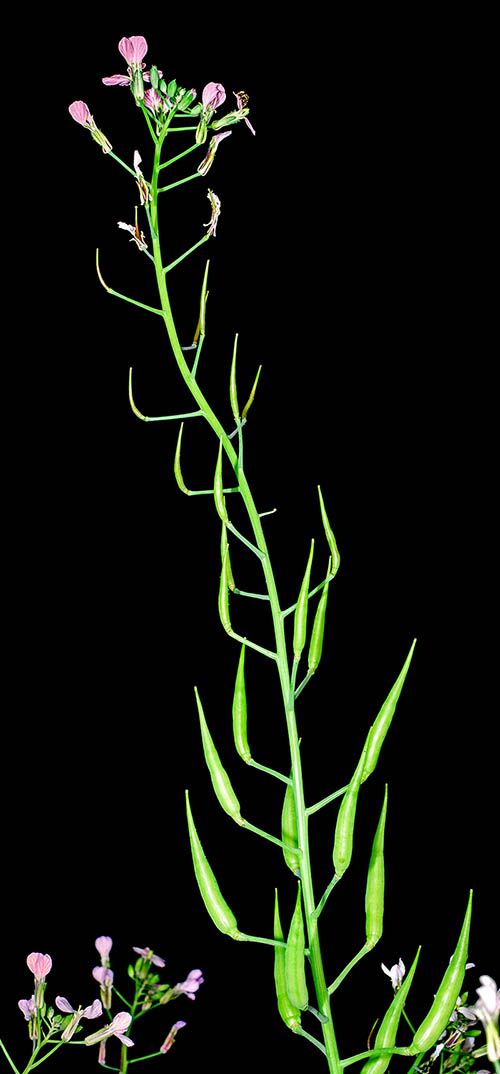
The fruits are indehiscent cylindrical siliques, divided in 2-12 monosperm compartments without narrowings or just hinted between the single seeds. The seedless beak is conical © Giuseppe Mazza
In the traditional European and Asian medicines, the radishes, since long, are utilized for treating diseases of the liver, of the respiratory tracts as well as natural remedy for fever.
Hippocrates (460 BC ca. – 377 BC) recommended its use against the oedemas. Pliny the Older (23-79) reports that the Greek physician Androcydes (IV century BC – III century BC) ordered his patients to eat radishes to prevent the intoxications caused by the excessive use of wine; He recommended the same to the king of Macedon, Alexander the Great (356 – 323 BC) he to a heavy drinker.
Pedanius Dioscorised (40 ca. – 90 ca.) in his “De materia medica” recommended the radish because caloric, good to eat, diuretic with the wine, bale to favour the peristalsis of the intestine and to cause menstruation.
Also the Schola Medica Salernitana considered the radish an excellent diuretic.
In antiquity, it was used also as a natural remedy against fever. In fact, it has been proved that the leaves crushed in water have an action against the flu virus.
Moreover, it has been proved that Raphanus sativus has diuretic and depurative properties. It has the capacity to enhance the antioxidant mechanism and to reduce emotional stress. It is also useful to diabetics thanks to its low glycemic index.
Laboratory analyses of the whole plant have found several substances such as: alkaloids, coumarins, enzymes, gibberellins, glucosinolates.
The radish can be recommended for the treatment and the prevention of diseases like those cardiovascular and the cancer and to delay aging.
The fresh radish stimulates the secretion of the gastric and biliary juices and has antiscorbutic properties.
Thanks to the presence of vitamins and of anthelmintic substances it is able to eliminate various types of worms.
The seeds of the radish contain a high percentage of oil and act as a mild laxative. The chromatographic analysis of these oil has shown their complete resemblance with the cottonseed oil.
The radishes contribute to relaxing the nervous and muscular systems thus favouring sleep. Moreover, if sipped in decoctions, they alleviate breathing difficulties and cough.
The extract of the root has antimicrobial activity against Bacillus subtilis, Pseudomonas aeruginosa, Micrococcus luteus, Staphylococcus epidermidis and Salmonella enterica, this last being responsible of the typhoid fever. It has been noted, also, that the watery extract of the roots has activity against the Streptococcus mutans, one of the reponsibles of the tooth decay, and against Candida albicans, saprophytic fungus that, in particular conditions, may behave as pathogen.
In the tuberiform roots of the radish are present four main organic acids: oxalic, malic, malonic and erythorbic. It also contains rafanol and glucobrassicin that furnish a medicamentous action, as proved by some studies that have detected their cholecystokinetic and antilithiatic properties, useful in the treatment of the biliary disorders.
In the seeds is present the raphanin, a sulphur component equipped with antibacterial properties, and the β-sitosterol that is thought to have antidiabetic, hypolipidemic, neuroprotective and antitumor effects.
The outer part (skin) of the black radish root, usually discarded and not consumed, based on a recent study, presents medicinal phytocomponents such as tannins, savonins, flavonoids, anthraquinones, carbohydrates, sugars, steroids, phytosterols, alkaloids, amino acids, terpenoids, glycosides and chalcones. Therefore, it is obvious that also the skin of the black radish has a high curative potential.
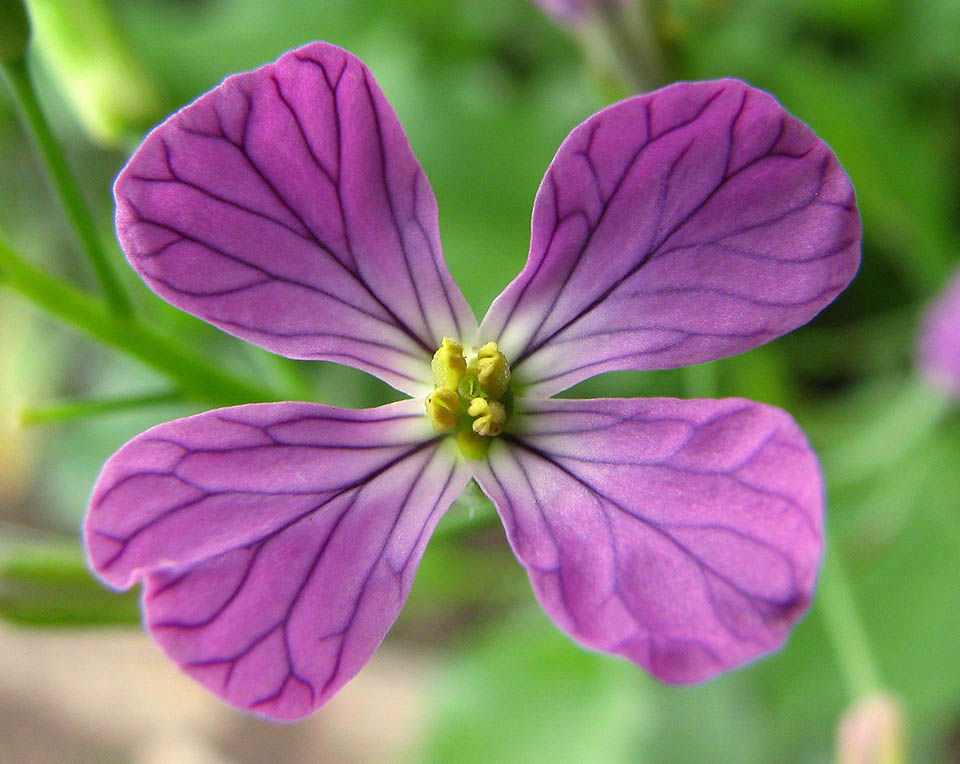
Details of the four petals flower typical to Brassicaceae. In centre, the ovary with the style and four superior stamens with well evident anthers © Hector Vasquez
Raphanus sativus is mainly cultivated for its fleshy roots that are consumed raw or cooked and generally accompany meat-based dishes because facilitate their digestion. Fresh, can be mixed with other vegetables ad also with tomatoes but are not recommended for the persons suffering from gastritis, gastroesophageal reflux and irritable colon because they may cause diarrhoea. Also the young leaves are edible and are cooked in the same way as the spinach. Are also consumed whole that are just sprouted seedlings.
Raphanus sativus grows better in full sun, in sandy soil with a pH varying from 6,5 to 7. It is also a very important plant in the seed industry of the whole world, especially in Asia.
Only two varieties of Raphanus sativus do exist nowadays deemed valid by the systematics here adopted.
Raphanus sativus var. caudatus (L.) Hook.f. & T. Anderson, that includes Raphanus caudatus L, is commonly known as Rat tail radish. This variety probably originated in Java Island due to spontaneous crosses during its cultivation. Unlike the species it does not produce a big root but the plant is utilized because of its edible fruits, up to 60 cm long.
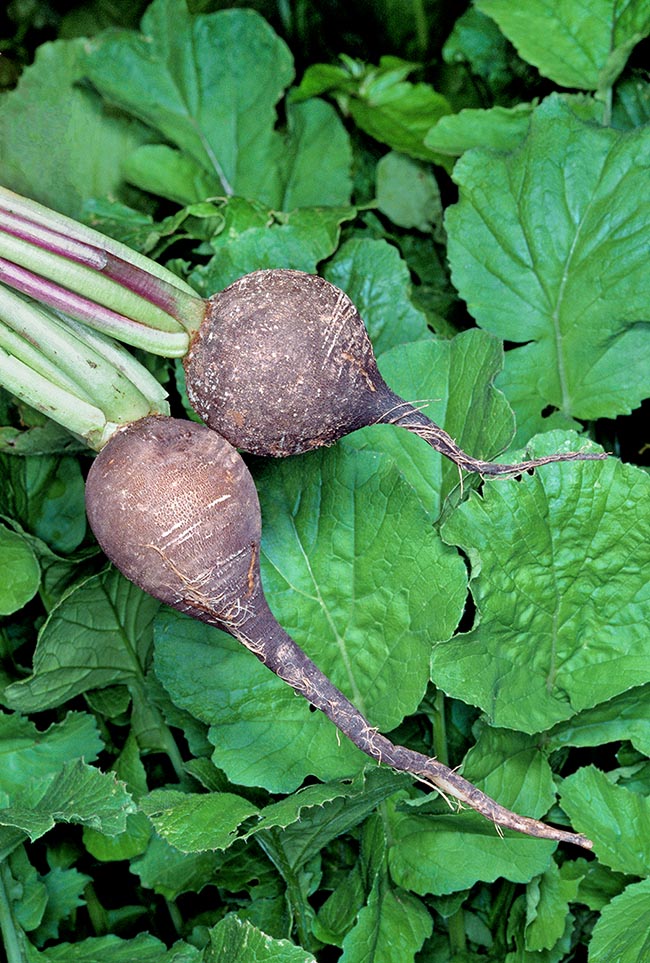
Very diffused even yore, the Black radish (‘Black Spanish’) is a winter variety that can be kept for long periods of time. The skin is coarse, blackish. The pulp is white, crunchy, with hot and spicy taste © Giuseppe Mazza
Because of this characteristic it soon spread in India and in China and in the nineteenth century in Europe where it was called “Snake radish”. It is an annual plant, up to 50 cm tall, that produces abundant flowers of pale pink or light blue colour. Besides the fruits, are utilized the young leaves, raw or cooked, with a delicately spicy flavour and also the flowers. The fruits are consumed, when unripe, raw in salads or sauteed in the pan, but also in sweet-and-sour sauce, in pinzimonio and pickled.
Raphanus sativus var. sativus includes a lot of cultivars and of hybrids F1 easy to find commercially.
The biological cycle of the radish is very short, varying from 30-40 days (early cultivars) to 60-70 days (late cultivars). Generally, the collection is done manually, and consists in the uprooting of the plant, then washing and confection.
The numerous horticultural forms on the market are usually classified according to the earlyness , the shape and the colour of the root.
Commonly there are radishes for all the month, summer or autumn radishes and winter ones.
Furthermore, the western radishes are usually small, with a relatively short ripening time, three to four weeks, whilst the eastern radishes are very big and require more time for growing.
The western ones have pungent flavours and are used mainly as seasoning or appetizer and to embellish with their colour, the dishes. The eastern radishes, called Daikon (大根 , from 大, big and 根, root), are crunchy and have a very delicate taste. They are called white or Japanese or Chinese winter radishes.
The radish daikon is very popular in the Japanese, Chinese and, generally, Asian cuisine. The plant resembled a big white carrot and is commonly consumed raw, cooked or in brine.
Daikon is not just tasty and refreshing but has a low calorie content and is also rich in vitamin C, necessary for the production of collagen, a protein that enters the composition of the connective tissues, such as skin, tendons, bones and cornea.
As this vitamin is thermolabile, it is good to use raw daikon. If grated, in Japan it is called “daikon oroshi” and is utilized, usually at the end of heavy meals, like fried food, as its enzymes facilitate digestion.
Similar to daikon is the Korean radish, called Mu (무) that has the shape of a potato and it too is a winter radish very utilized for the soups of radishes and beef (Soegogi Muguk).
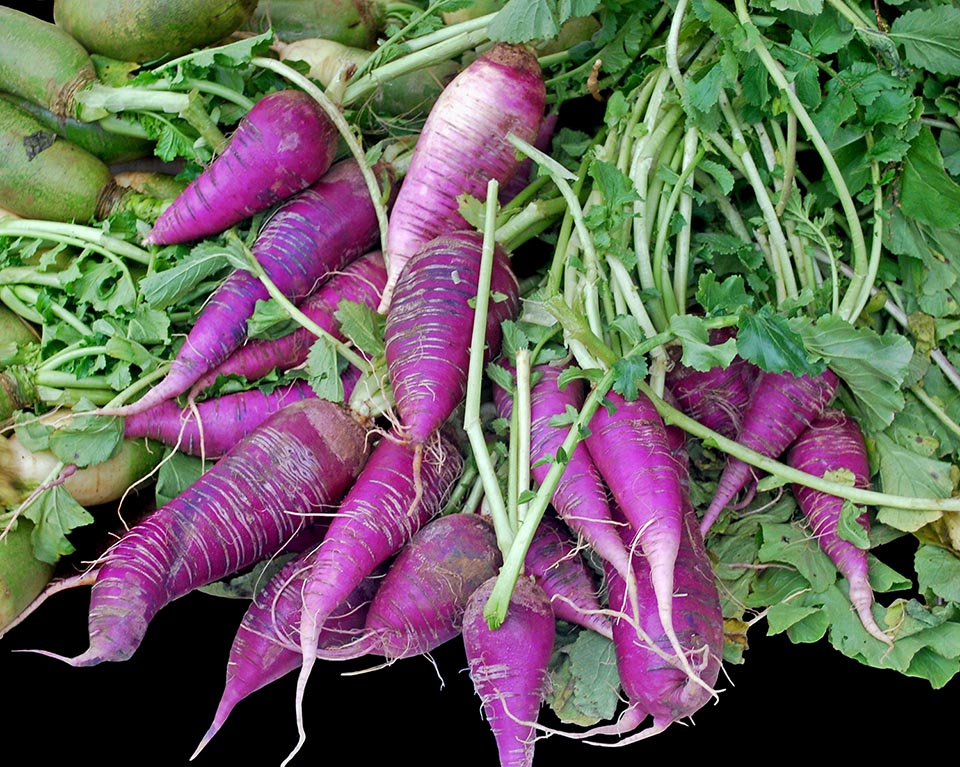
‘Purple Daikon’ has medium-big roots, 15-25 cm long, cylindrical in shape with blunt and curved extremities. The skin with more or less dark violet hues, is semi-smooth, coarse and firm. The taste is delicate, slightly sweet and somewhat peppery. It contains less water than the white daikon and the pulp is crunchy © Howard Walfish
In Japan from the roots of the daikon they prepare the takuan, traditional pickle served by the end of the meal in order to help the digestion. The cooked roots serve for the soups of miso that are based on seeds of yellow soy (Hatcho Miso) To the soy can be added barley (Mugi Miso), rice (Kome Miso), rye, buckwheat or millet.
It is estimated that in Japan are utilized about 500.000 tons of daikon per year.
In Europe and in Japan the radish is found in the markets during the whole year, thanks to the many cultivars grown, even if the season of production goes from April to June and from October to January.
In summer they ripen more quickly, and many cultivars sprout in 3-7 days and reach full maturity after three or four weeks. The collection periods may be extended with repeated sowing, alternating for one or two weeks.
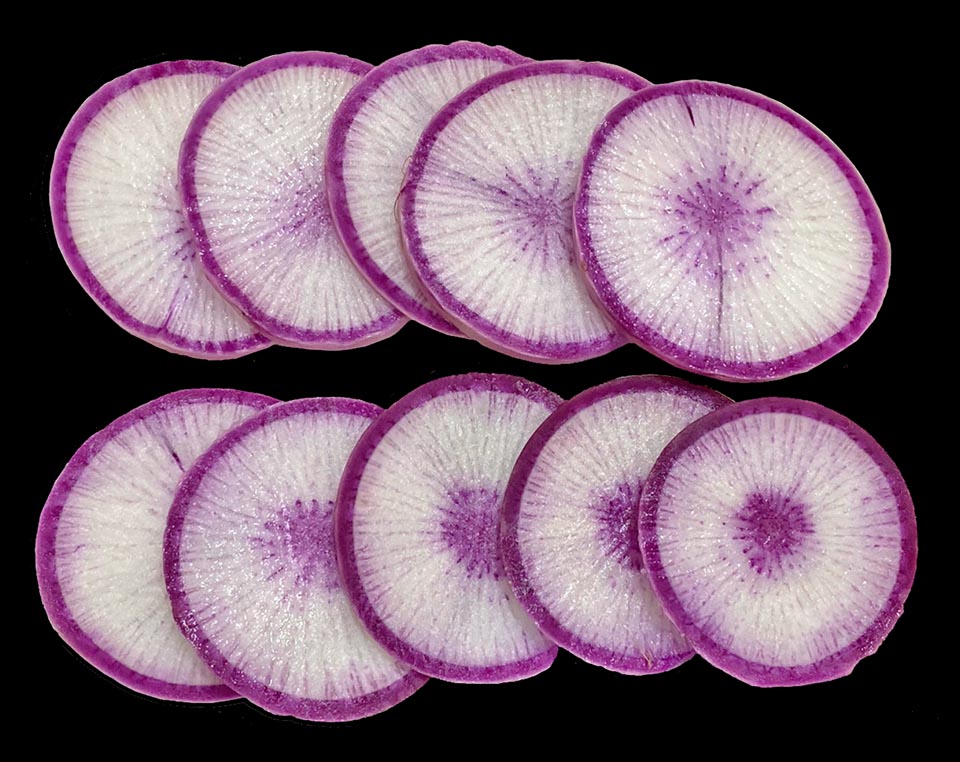
Appetizing slices of ‘Purple Daikon’. The pulp is bicoloured, with violet stripes on white base and a dark violet ring just under the skin.© B Tommie Usdin
Many are the cultivars of Raphanus sativus present on the world market. Those with long and white roots are the oldest whilst nowadays the most requested are those with round roots and of usually red colour.
‘Sakurajima’ is a cultivar cultivated in Japan on volcanic rocks and so called because it was selected on the volcanic island of Sakurajima (Kagoshima Prefecture). It’s the biggest cultivar of radish in the world, vulgarly known as Daikon of Sakurajima or Giant Daikon.
It is an erect and ramose plant, about 10 cm at the base long leaves divided in segments, progressively shorter towards the apex and root that may reach the 50 cm of diametre and 27 kg of weight. Blooming occurs in late winter, with pale pink flowers grouped in racemose inflorescences. The fruits are siliques swollen in the centre that ripe several seeds. It is a sweet cultivar and is utilized raw as well as cooked as a side dish for fish dishes because it facilitates their digestion.
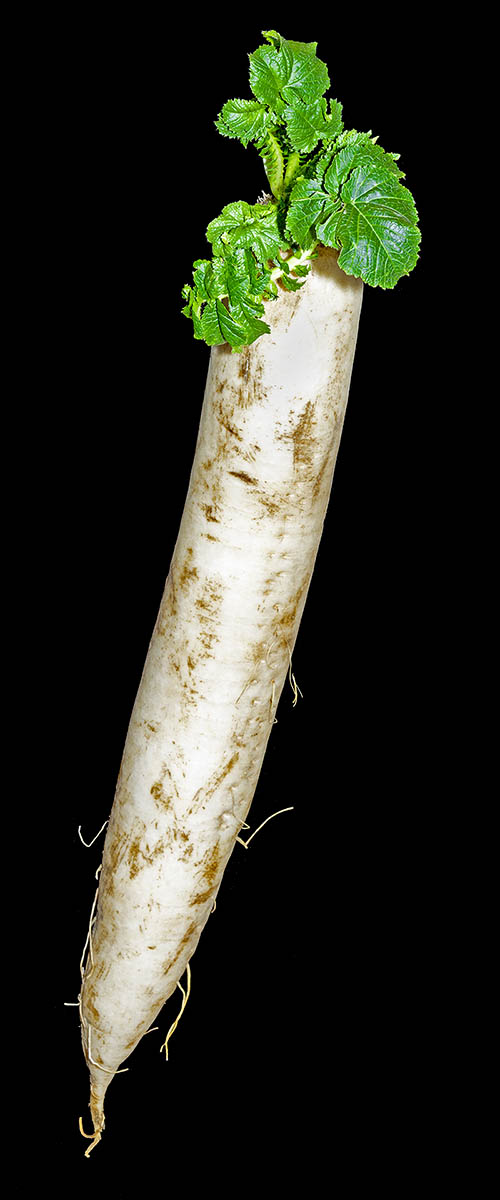
The daikon radish is very popular in the Japanese, Chinese and generally Asian, cuisines. Looks like a big white carrot, that can be consumed raw, cooked or in brine © G. Mazza
‘Miyashige’ is a Japanese autumnal saikin radish, of very high quality. The cylindrical white roots are of pale green colour near the crown of the leaves and measure 40 to 45 cm of length and 5-6 of breadth; The pulp is crunchy and tender, suitable for conservation. Sowing is done in July or in early August, in fact, it is a winter radish requiring a reduction of the day duration and cool temperatures to form in about 60 days. It is utilized for soups, salads, in brine or fresh.
‘Purple Daikon’ has medium to large roots, 15 to 25 centimetres long and of cylindrical shape with the extremities bevelled and curved. The skin is semi-smooth, coarse and firm, with pale violet to darker violet shades. The pulp is dense, crunchy and bicoloured with violet stripes on a white base, and, sometimes, with a dark violet ring just under the skin. These radishes contain less water and crunchy pulp compared to the daikon white cultivars. They also have a delicate taste, slightly sweet and peppery. The warm temperatures favour the forming of pungent and spiced roots, whilst the cooler ones create radishes little peppery. If cooked, they present a consistency similar to that of the potatoes. The leaves, of dark green colour, are edible with a light peppery taste.
‘April Cross’ is a giant hybrid of white radish “daikon”. It produces big and up to 40 cm long roots, of 6 cm of diametre and 800 grams of weight. The skin and the pulp are white and the pulp has a delicate taste with a crunchy and juicy consistency. ‘April Cross’ is excellent for salads, cooking and in brine. The recommended collection goes from late spring to early summer.
‘Red Meat’ is a cultivar of daikon with round roots, white outside, with sweet and juicy pulp of pinkish red colour. It is excellent for salads, marinating and cooking.
‘Watermelon’ similar to the previous one and at times mistaken for it. It has a swollen round root from 5 to 10 cm, depending on the date of collection. It is called ‘watermelon’ due to the pinkish red colour of its sweet and juicy pulp. It is a type of daikon radish requiring a ripening time of 70-100 days. Usually, it is served sliced, thin and raw, in order to maintain its colour, but is also good for marinating and fermentation.
‘Rover’ is an early F1 radish with smooth roots, of dark red color and white crunchy pulp.
‘Sora’ produces round roots of red colour with big green leaves. It is suitable for spring, summer or autumn cultivations.
‘French Breakfast’ – this cultivar of radish is ready for use in six weeks after sowing. It was created in 1879 and became a popular radish in the Parisian fruit and vegetables markets. The root is of medium size, long, of red colour with white point and leaves that can be utilized also for salads. The French radish is often consumed raw due to its slightly peppery taste and its crunchy consistency but can also be cooked. Even if this cultivar is called “French breakfast”, the French do not eat these radishes in the morning but as a snack, at times dipped in salt, at times lightly buttered and served on toasted baguettes.
‘Riesenbutter’ has red roots famous for their aromatic taste that is well suited for salads. The plant grows in a rosette from 15 to 20 cm of height and 15 to 20 cm of breadth. It is cultivated in full sun, with well drained and fertile soil and collection is done from June to October.
‘Eiszapfen’ is a cultivar known as ‘icicle radish’ due to its white and long roots and its aromatic taste. It is mainly utilized for salads.
‘Cherry Belle’ is a radish very diffused in the North American supermarkets but also in France. It is a warm season cultivar, with small, round, smooth, scarlet roots and with spicy and white pulp. They are excellent if roasted and mixed with lemon and brown butter tasting hazelnut. They are good for appetizers based on raw vegetables (crudité) and, also, for soups.
‘Champion’ is a cultivar similar to ‘Cherry Belle’, with scarlet root, but bigger, up to 5 cm, and with crunchy pulp having a more delicate taste. The root can be consumed whole or sliced in salads.
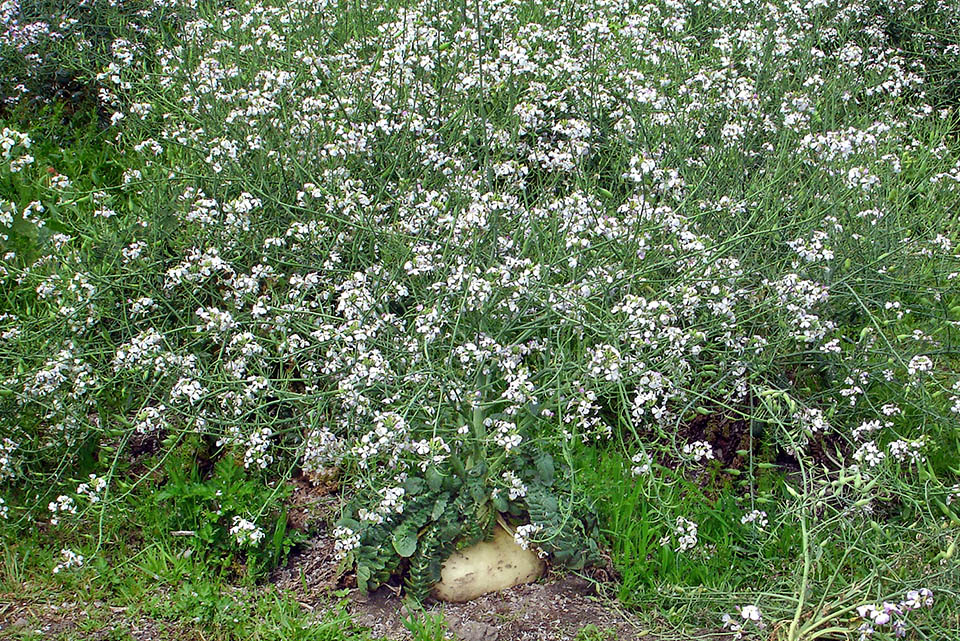
‘Sakurajima’ grown in Japan, on the volcanic ashes of the Sakurajima, is the biggest radish in the world. Erect posture, racemose and pale pink flowers. © Jeff Houze
‘Sicily Giant’, similar to ‘Cherry Belle’ is a rustic Sicilian cultivar with a short cultivation cycle reaching the dimensions of 6 cm of diametre. It is a summer radish with a round root of bright red colour. The pulp is white, the taste is pleasant and sweet, and is, therefore, a very delicate radish. In Sardinia is cultivated a similar cultivar, ‘Sardinian Giant’, but with a medium-late vegetative cycle and with round roots of 5 cm of diametre, of scarlet red colour and firm and crunchy pulp.
‘Bunny Tail’ is an Italian spring-summer cultivar, that has a slightly oblong shape, of bright red colour with white point, pleasantly crunchy and with delicate taste.
‘White Icicle’ is a white cultivar shaped like a carrot, about 10-12 cm long that dates back to the XVI century. It is easily sliced and has a better consistency than the average of the other cultivars.
‘Plum Purple’ has a purple-fuchsia root, crunchy, and a delicate and peppery taste. The root is globose and ripens quickly, tending to keep crunchy for a long time.
Striking image of a ‘Sakurajima’ full of siliques, swollen at the centre, that ripe the seeds. The spherical root is utilized often, raw or cooked, as side dish of dishes based on fish because facilitates their digestion © Tomas Krist
‘Black Spanish’ is a winter cultivar, very diffused also in the past. The Spanish black radish was present in England and in France at the beginning of the XIX century and in 1824 it was introduced in the New World. It is a winter radish that can be kept for a long period. The root is round (Black Spanish Round) with a diametre of about 10 cm or elongated (Long Black Spanish) with a length of 17-20 cm. The skin is cparde, black, and the pulp is crunchy white with hot and spicy flavour. It can be roasted, braised or fried in a pan. After cooking, it may be crushed and mixed with cheese and sour cream to spread on the roasted meats. Pickled, it is used as a spicy element in the traditional Korean dish kimchi, made of fermented vegetables. The black radishes can be found all over the year, with a peak season from autumn to early spring.
‘Flamboyant 3’ is a cultivar producing a cylindrical medium-long root (about 5 cm), of a nice bright red colour, with white tip and firm pulp having a lightly spicy taste. Its vegetative cycle is medium-precocious. Sowing is to be done from March to September and collection three-four weeks after sowing.
‘Long of Naples’, this cultivar known as ‘Lungo di Napoli’, is quite rustic, precocious and suitable for the cultivation in open fields. It has short leaves and long roots, of cylindrical shape, of red bright colour with white point and with firm and crunchy pulp.
‘De dix-huit jours’ is a cultivar with a short period of growth, eighteen days about, that can be harvested throughout the spring and autumn. The roots are cylindrical, 4-5,5 cm long, of bright red colour and white point. Its pulp is white, crunchy and has a mild taste suitable for being added to salads.
Synonyms of Raphanus sativus L.
Raphanistrum gayanum Fisch. & C.A. Mey., Raphanus acanthiformis Morel ex Sasaki, Raphanus candidus Vorosch., Raphanus gayanus (Fisch. & C.A. Mey.) G. Don ex Sweet, Raphanus sativus var. longipinnatus L.H. Bailey, Raphanus sativus var. radicula Pers., Raphanus taquetii H. Lév.
Synonyms of Raphanus sativus var. sativus L.
Raphanus acanthiformis var. gigantissimus Nakai, Raphanus chinensis Mill., Raphanus macropodus H. Lév., Raphanus niger Mill., Raphanus raphanistroides (Makino) Sinskaya, Raphanus rotundus Mill., Raphanus sativus f. raphanistroides Makino, Raphanus sativus var. hortensis Backer, Raphanus sativus var. niger (Mill.) J. Kern., Raphanus sativus var. raphanistroides (Makino) Makino.
→ For general notions about BRASSICACEAE please click here.
→ To appreciate the biodiversity within the BRASSICACEAE family please click here.
